february 6–april 17, 2003
berkshire patrons
As a struggling young painter in the late 1840s and early 1850s, Inness was helped by four influential people with links to the Berkshires. Ogden Haggerty and Samuel Gray Ward were businessmen, Catharine Sedgwick a popular author, and the Reverend Henry Ward Beecher a prominent clergyman. These patrons all had summer houses in the Berkshires and moved in the same social circles in both country and city. While Haggerty and Beecher collected Inness's work, Sedgwick, with whom Inness may have briefly collaborated, and Ward, who helped him financially, may have further encouraged the artist to visit and paint scenes of the Berkshires.
OGDEN HAGGERTY
Ogden Haggerty (1810-1875) was a New York entrepreneur and Inness's first patron. After encountering the young Inness at his easel in an open square in New York, Haggerty paid the artist $100 to have the painting delivered to his home on Warren Street. The collector commissioned work from numerous artists, including Inness, Asher B. Durand, Thomas Cole, and Jasper Francis Cropsey, and it was Haggerty who helped Inness obtain a passport and then paid for the artist's first trip abroad, to Italy, in 1851--52. In about 1853 Haggerty built an Italianate villa in the village of Lenox that he named Vent Fort ("Strong Wind"). In 1891 this house was moved across Walker Street by George and Sarah Morgan to make way for the present-day Ventfort Hall. The old Haggerty house, last used by Berkshire Country Day School, burned in 1965.

Ogden Haggerty, c. 1860-65
Courtesy Lenox Library Association, Lenox, Massachusetts
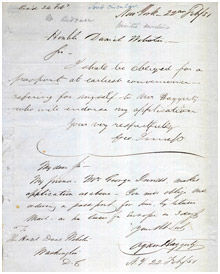
Passport application letter from Inness to Secretary of State Daniel Webster, endorsed by Ogden Haggerty,
February 22, 1851
National Archives and Records Administration
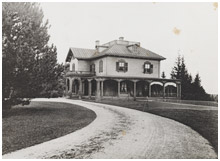
Vent Fort, c. 1886
Photograph from Lenox (East Lee, Massachusetts, 1886) by E. A. Morley
SAMUEL GRAY WARD
In 1844, Bostonian Samuel Gray Ward (1817-1907) purchased property in Lenox and engaged the architect Richard Upjohn to design a house, Highwood. Much altered by subsequent owners, the house today stands on Tanglewood's property near Ozawa Hall. Ward's second house, Oakwood, was designed in 1876 by Charles F. McKim. In 1893 when Anson Phelps Stokes bought the property and built Shadowbrook, he converted Oakwood to stables. The structure burned in 1903; its site is now owned by Kripalu. Ward was a banker of international prominence as the American representative for Barings Bank of London. He and his wife Anna were life-long friends of the Haggertys. At the end of his life Ward annotated a letter in which Inness had asked Ward for help selling a painting, "G. Inness became the most distinguished landscape painter of his time."
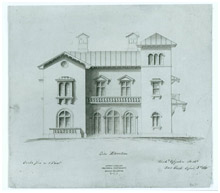
Drawing by the architect Richard Upjohn, recently identified as Highwood, 1845
Avery Architectural and Fine Arts Library, Columbia University in the City of New York
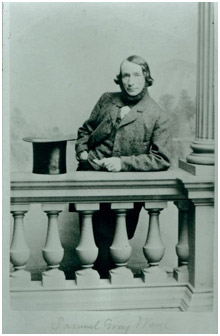
Samuel Gray Ward, c. 1860
Emerson Papers, Houghton Library,
Harvard University
(bMS Am 1280.235.706.29 photo album, picture # 27)
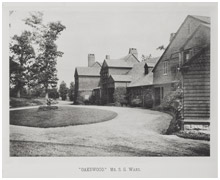
Oakwood, c. 1886
Photograph from Lenox (East Lee, Massachusetts, 1886) by E. A. Morley
CATHARINE SEDGWICK
A Berkshire native, Catharine Sedgwick (1789-1867) was one of the earliest American women novelists. Beginning with the publication of A New England Tale in 1827, she wrote six widely-read novels, as well as pieces that were published in popular literary magazines. She spent most summers either at her father's house on the main street of Stockbridge, or at her brother Charles's house in Lenox, known as The Hive, which first stood on Walker Street across from the town hall before the Sedgwicks moved it to a more dramatic site in 1850. The house was demolished in 1903 for the construction of the John Alexandre house, Spring Lawn, now owned by Shakespeare & Company. Catharine Sedgwick's wide circle of friends included Ogden Haggerty and Samuel Gray Ward, and as part of this group of Inness enthusiasts, she may have suggested using the artist's work on the title page of the 1849 edition of her novel Clarence.
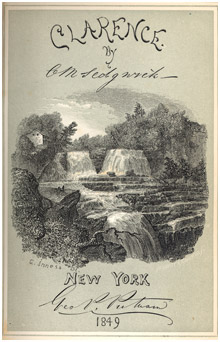
Trenton Falls (The Mill Stream), c. 1849
Etching and engraving.
Title page of Clarence by Catharine Maria Sedgwick
Courtesy of the Berkshire Athenaeum, Pittsfield, Massachusetts
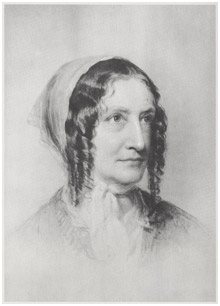
Catharine Maria Sedgwick, c. 1850
Charcoal and chalk on paper by Seth Wells Cheney
Courtesy Lenox Library Association,
Lenox, Massachusetts

The Hive, c. 1880
Courtesy Lenox Library Association,
Lenox, Massachuetts
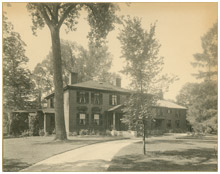
Catharine Maria Sedgwick, c. 1850
Charcoal and chalk on paper by Seth Wells Cheney
Courtesy Lenox Library Association,
Lenox, Massachusetts
HENRY WARD BEECHER
Henry Ward Beecher (1813-1887) became the minister of Plymouth Congregational Church in Brooklyn in 1847, preaching sermons and writing books that gained him wide renown. He was an important collector of Inness's work, owning at least seven paintings at the time of his death. Lecturing on art in 1865, Beecher conveyed his deep appreciation of Inness's paintings as "steeped and saturated with feeling." From 1853 to 1857 Beecher summered with his family in a simple farmhouse in Lenox called Blossom Farm, which stood on the hilltop site of today's Cranwell resort. Catharine Sedgwick's letters tell of Beecher's breakfasting with her family at The Hive and preaching at the Church-on-the Hill on Sundays in August. Beecher's invitation to Inness to visit his summer home in Peekskill, New York, indicates their continued friendship after the clergyman's years in Lenox.
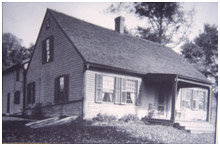
Blossom Farm,
Courtesy Lenox Library Association, Lenox, Massachusetts
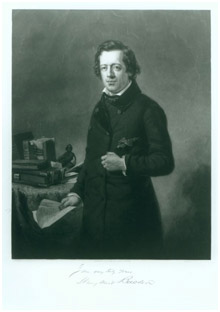
Henry Ward Beecher, c. 1853
Engraving by John C. McRae after the painting by Thomas Hicks
Courtesy Library of Congress
Area Map
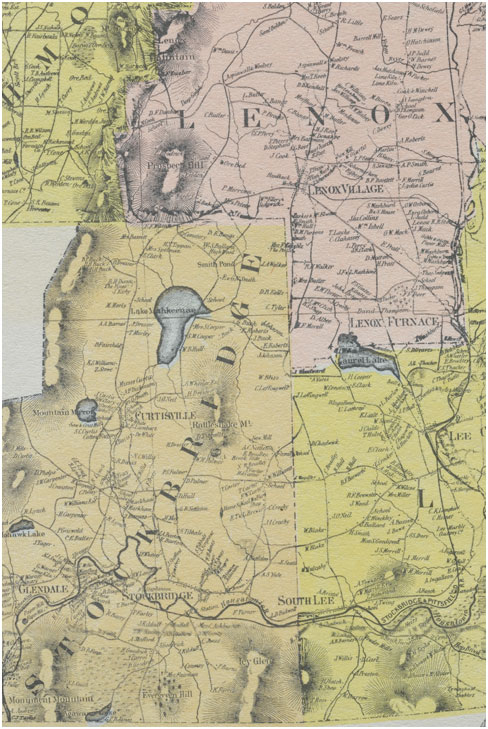 Map of Central Berkshire, Massachusetts (detail showing Lenox), 1858
Map of Central Berkshire, Massachusetts (detail showing Lenox), 1858
By H. F. Walling and Company
Williams College Archives and Special Collections
